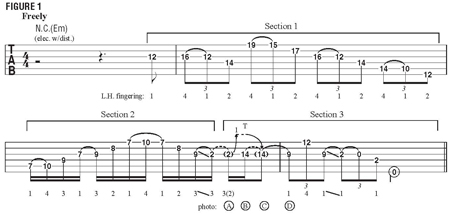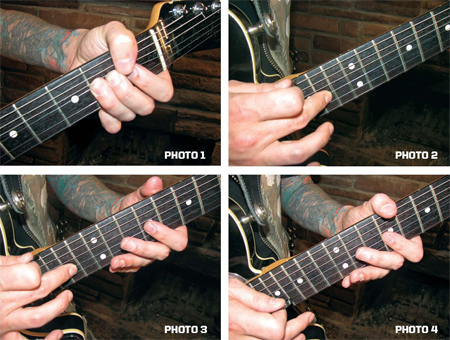
Arpeggios, octaves, long slides and an octave finger tap.
Welcome to my first in a series of monthly columns for Guitar World. As an avid reader of the magazine for many years, I’m excited and honored to be writing my own column.
Over the next several months I’m going to be discussing different styles of playing and how you can incorporate them into your rock work. The styles I’ll be looking at will include jazz, country, Spanish flamenco and classical-sounding arpeggios. Hopefully doing this will open both your mind and your ears to new ideas and ways of approaching the instrument.
My interest in this approach began when I was on tour with a country act. I was doing my usual rock thing within that context, but at the same time I was exposed to great country players who employed amazing techniques, like chicken pickin’ and banjo rolls. As much as I love playing rock, I thought it would be really great to not only learn other techniques but also incorporate them into my own style. That’s what inspired me to take this approach, and it’s what drives me to continue to do so as a solo artist and as the guitarist for Rob Zombie.

To start, I’m going to demonstrate a fairly classical-sounding passage in E minor that incorporates arpeggios, octaves and a simple but neat-sounding octave finger-tap trick. The passage in question is shown in FIGURE 1. To make this short piece easier to learn, I’m going to break it down into three smaller, bite-sized chunks. And to make the explanation even clearer, I’ll dissect each section and play it slowly with a clean sound in the accompanying video lesson to this column so that you can see, as well as hear, exactly what I’m doing and talking about. I suggest you master each section before moving on to the next one.
The first section is a Paul Gilbert–style lick in which I’m playing the exact same E minor arpeggio (E G B) in three different octaves and in three different positions on the neck. As you can see, the arpeggio is made up of G, B and the root note, E; it’s played in 12th, 15th and 10th positions and involves a wide-stretch pull-off between the B and G notes in each octave.
The second part is basically a two-octave Em7 arpeggio (E G B D) played across the neck in ninth position. As you can see, the arpeggio begins on the E note at the seventh fret on the A string and ascends across the strings to the D at the 10th fret on the high E, before descending back to the E note at the G string’s ninth fret. Once you’ve nailed the first two sections, make sure you can play them at speed back-to-back before moving on to the third and final section.
All the latest guitar news, interviews, lessons, reviews, deals and more, direct to your inbox!

Section three begins with a fairly long slide, from the E note at the ninth fret on the G string down to the A at the second fret, followed by a full-step bend (see PHOTO 1) and then a tap on the bent string at the octave A note on the 14th fret with the pick-hand middle finger (see PHOTO 2). While holding the tapped note, I release the bend and then use the tap as a “pause” button. This enables me to move my fret hand back up the G string to finger the E note at the ninth fret with my index finger (see PHOTO 3) before pulling-off my tapping finger to that note (see PHOTO 4). This is followed by a string-skipped octave E between the G and high E strings, before a slide back to the A, at which point I finish the lick in open position.
Learn this in sections, and you’ll master it in no time. Good luck, and see you next month!
